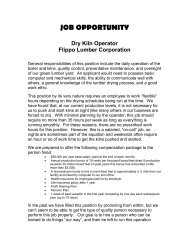Assessing the Mechanical Properties of Black Ash - Department of ...
Assessing the Mechanical Properties of Black Ash - Department of ...
Assessing the Mechanical Properties of Black Ash - Department of ...
You also want an ePaper? Increase the reach of your titles
YUMPU automatically turns print PDFs into web optimized ePapers that Google loves.
<strong>Assessing</strong> <strong>the</strong> <strong>Mechanical</strong> <strong>Properties</strong> <strong>of</strong> <strong>Black</strong> <strong>Ash</strong>(Fraxinus nigra M.) grown in <strong>the</strong> Thunder Bay SeedZone for use in Value Added Forest ProductsBrent ForbesDr. Ma<strong>the</strong>w LeitchDr. Chander ShahiLakehead University, Thunder Bay, OntarioISCHP 2011, <strong>Black</strong>sburg Virginia, October 2011
Ontario’s Forest Economy• Vital component <strong>of</strong> <strong>the</strong> Canadian economy– Province’s largest industry; $15 billion• Economic downturn over <strong>the</strong> last decade– 40 manufacturing facilities closed• Worldwide demand for forestproducts is steadily increasing• Become more competitive,capitalize on emerging markets andutilize Northwestern Ontario's vastwood supply
Research Objective• Identification <strong>of</strong> underutilized species with potential fordevelopment and increased marketing potential• Complete understanding <strong>of</strong> <strong>the</strong> variation in physical andmechanical properties <strong>of</strong> <strong>the</strong>se species in Northwestern Ontario• How this knowledge can be applied to end use attributes invalued added manufacturing• Allow <strong>the</strong> forest sector to better utilize resources and competemore effectively in global markets.
<strong>Black</strong> <strong>Ash</strong>• Fraxinus nigra Marsh.• Slow growing hardwood– Frequently on wetland ormesic Sites– Upland , mixedwood sites• .4% <strong>of</strong> provincial growing stock– 20 million cu/m 3 across <strong>the</strong>province• Flooring, mouldings, furniture,handles, novelties
Methodology
Sample Preparation
Property Testing• Modulus <strong>of</strong> Elasticity• Modulus <strong>of</strong> Rupture• Specific Gravity• Janka Ball Hardness• Compression Parallel to Grain• X-Ray Densitometry• Growth Rate
Methodology1. Juvenile core2. Juvenile andmature transition3. Heartwood andsapwood1004. Outer sapwood751 2 3 45025juvenile woodZones <strong>of</strong>radialsimilarityZones <strong>of</strong>longitudinalsimilarityZones <strong>of</strong>mature &juvenile woodWoodpropertymapping
Results – Modulus <strong>of</strong> Elasticity4• 4,912 to 11,899Mpa• 8,307 Mpa average• 3 distinct sites• Longitudinalsubsets1 2 3 4321
Results – Modulus <strong>of</strong> Rupture4• 48 to 114 Mpa• 87 Mpa average• 3 distinct sites• Little variation inei<strong>the</strong>r direction321
Results – Relative Density 12%4• 546 to 753• 650 average• 2 subsets <strong>of</strong> sites• Consistent trends1 2 3 4321
Results – Janka Ball Side Hardness4• 1,544 N to 7677 N; 5410 N Average• 2 subsets <strong>of</strong> sites• Insignificant radial variation• Homogenous subsets within stem• Consistent longitudinal trends1 1 22 3 4321
Key Findings - Trends• Consistent radial trends with little variation– No change from heartwood to sapwood, juvenile tomature– Large heartwood area with consistent properties• Little variation in longitudinal bolts– Consistent properties from stump to crown– First bolt shows potential for increased properties• Homogenous wood properties with potential forpredictive models
Key Findings - Site• Site was a significant factor for each<strong>of</strong> <strong>the</strong> properties examined– 3 distinct sites or 2 subsets for each <strong>of</strong><strong>the</strong> properties– Wet vs. drier upland• How consistent is site in relation toproperties?• Prediction <strong>of</strong> properties based on sitecharacteristics– Wet vs. dry– Ecosites
Utilization Potential• Inherent properties and underutilizednature <strong>of</strong> black ash make it desirable for anumber <strong>of</strong> products• Growth rate plays a significant role in <strong>the</strong>inherent properties– Earlywood to latewood ratio– Faster growth results in higher woodproperties– Potential for increased utilization in shortertime frames• Higher hardness values <strong>the</strong>n any speciesin <strong>the</strong> region provides potential for valueadded flooring
Future Utilization• Emerald <strong>Ash</strong> Borer– Not in <strong>the</strong> Northwest– Concerns with small woodlot and urban trees– Unclear <strong>of</strong> <strong>the</strong> widespread effect on native ash• Future supply <strong>of</strong> ash?– Reduced supply <strong>of</strong> competing hardwoods• Better management practices
Fur<strong>the</strong>r Research• Completion <strong>of</strong> detailed property maps forblack ash stems• Stand attribute data• Height, DBH, health, defects etc• Provide <strong>the</strong> value and quality <strong>of</strong> black ash• Understanding <strong>of</strong> potential yields,products and markets with a focus onsmaller, value adding businesses inNorthwestern Ontario
I would like to acknowledge <strong>the</strong> following:• Lakehead University Wood Science and Testing Facility• Ontario Ministry <strong>of</strong> Natural Resources• Nor<strong>the</strong>rn Ontario Heritage Fund Corporation• FedNor and <strong>the</strong> Nor<strong>the</strong>rn Ontario Development Program














